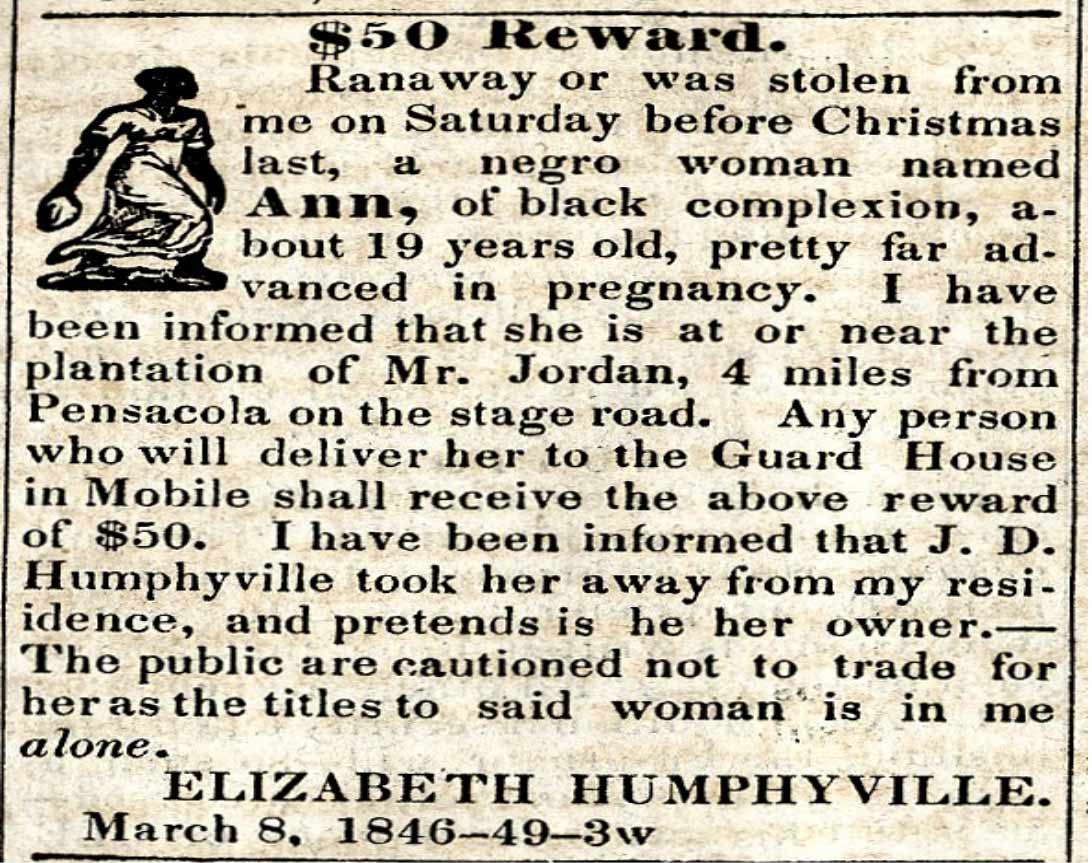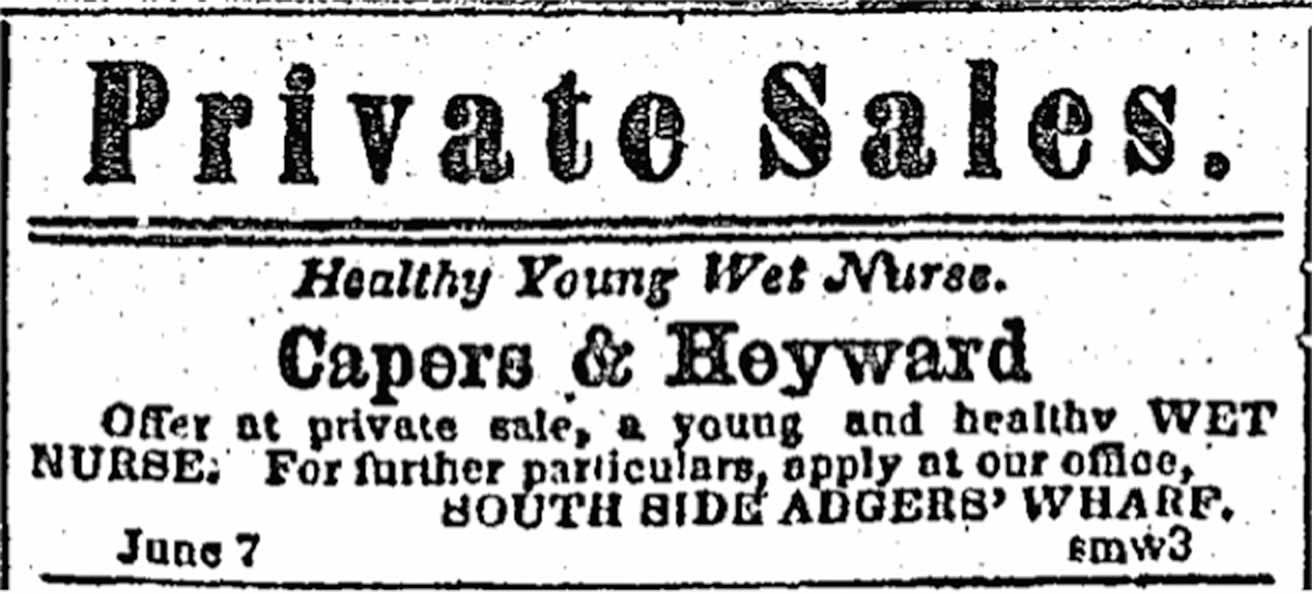By 1836, Sarah Barnes had become something of an Alabama magnate. She owned a home, land, rental properties, 10 stocks in a local bank in Mobile, and 27 enslaved people. On the eve of her marriage to Dennis Welsh, Barnes drew up an antenuptial agreement, a legal document outlining the terms of their union. In it, she stated that she would continue to have “sole, entire and exclusive use, benefit, and enjoyment” of her property. All of the rent collected on her real-estate holdings would continue to go to her, as would any potential wages earned by her enslaved people rented out for their labor. Barnes engaged a trustee, Richard Redwood, to help her manage her holdings, but he was allowed to take action only if she delivered him written instructions, produced in the presence of “six reputable persons and in the absence” of her husband-to-be. She also reserved the right to make her own will, which was to be drawn up in the presence of four people—one of whom had to be a clergyman—then signed, sealed, and published so that Dennis could not change its terms after her death.
Six reputable persons? A clergyman? What can account for Barnes’s exacting enumeration of her property rights and her palpable worry about her future husband’s meddling? She knew that when she married Dennis Welsh, she would become, in the parlance of the period, a “feme covert,” or a covered woman. She’d lose the right to bring suit, make contracts, and own property. All of it, her small empire of fields and flesh, would become his. And losing her enslaved people—this would be the bitterest pill of all, because in these people, so much of her wealth resided, and in the ownership of them, so much of her power. Her antenuptial agreement marked her refusal to give them up.
This is a remarkable, appalling document. It is an archive of a woman who navigated a legal system designed to exclude her, in a country where she wouldn’t be able to vote for another 84 years. And yet, there is absolutely nothing feminist about this document, because while it may bear the imprint of a woman who broke with common law and gender expectations, it simultaneously exposes why she did so, and at whose expense. Barnes doubled down on slave ownership, embracing white supremacy as a means to overcome her disempowerment on the basis of gender. Her opposition to patriarchy and her subjugation of black people were one in the same; in fact, they were mutually constitutive.
Barnes was not alone in using slave ownership to gain back some of the money and power allotted to her under patriarchy. The historian Stephanie E. Jones-Rogers’s They Were Her Property: White Women as Slave Owners in the American South is a definitive account of how deeply invested white women were in the slave economy of the South. Jones-Rogers’s book is a compendium of the actions taken by white women to preserve the wealth they had in human flesh as theirs alone. It scrupulously dismantles any image of slave-owning women as somehow less involved, less culpable than their male counterparts. Jones-Rogers also makes a case for why these slave-owning women were so motivated to protect their status as slave owners, and her answer has to do with the racial logic of capitalism.
Recent studies of the economics of slavery have shown that plantations were financially unstable places—bankrolled on credit, often intractably in debt, and subject to the perennial busts of the system of transatlantic capitalism, of which plantation slavery was a crucial part. For women, Jones-Rogers argues, independent wealth represented a bulwark against the financial risk their husbands assumed when they played the speculative cotton market. Should all be lost, at least their money would be safe; so would their status—as dominant people. Slave ownership provided white women with a mechanism for joining their male counterparts in the ruling class, which might otherwise have been closed off to them. Wealth and racial domination could get them there. Thus they (quite literally) capitalized on their whiteness to gain power, and they did so at the devastating and ongoing expense of black people, and black women in particular.
Popular
"swipe left below to view more authors"Swipe →
“Her presence made the plantation a home; her absence would have made it a factory,” wrote the historian Ulrich Bonnell Phillips of plantation mistresses in 1918. In Phillips’s account, the white mistress assumed the double responsibility of tending to her white children and to her black charges as well. She worked “with a never flagging constancy…. served as head nurse for the sick, and taught morals and religion by precept and example.” She was busy, as the plantation’s domestic manager and moral authority. Phillips’s then-influential account of the plantation household recapitulated the image of the white mistress promoted by the Lost Cause propaganda of the Reconstruction and Jim Crow South—that plantations were by and large happy places, thanks in no small part to the kindness and civilizing influence of white women.
This image of the kind, industrious plantation mistress has had a long life in representations of American slavery. It has bred a series of interrelated falsehoods, including the notion that mistresses were less physically violent toward enslaved people than were masters, and the myth that mistresses had secret alliances with enslaved women because they shared a similar kind of suffering under male dominance. This latter falsehood gained currency among women and feminist historians of the middle and later 20th century—Anne Firor Scott and Catherine Clinton, for example—who prioritized the category of gender over that of race in examining power relations under slavery. Some academics saw plantation mistresses as so constrained by patriarchy that they developed a more general critique of the subjection of women, both white and black, even if women at the time couldn’t speak about it. They were, the story went, “silent abolitionists.”
Historians and artists have been working to correct this false and sanitized view of plantation mistresses, and Jones-Rogers’s They Were Her Property is part of this movement. Her study builds on the work of historian Thavolia Glymph, whose groundbreaking book Out of the House of Bondage (2008) showed that white women harassed, beat, maimed, tortured, and killed enslaved people with as much brutality—and impunity—as white men. Mistresses categorically sided with masters, not with slaves, especially when it came to the administration of violence. Jones-Rogers’s work also aligns with recent representations of slavery in popular media and historical fiction, which have revised their portrayals of white women as the myth of a special feminine compassion has begun to be dismantled. Here, one might think of the distance between Scarlett O’Hara of Gone with the Wind and Mary Epps of 12 Years a Slave.
Jones-Rogers continues to fill in the violent picture set out by these revisionary—which is to say, accurate—representations. She writes, for example, of one woman who elected to whip enslaved people with the nettle-weed branch rather than the cowhide whip because the nettles burrowed under the skin and left a long-lasting burn—but did not scar, and thus did not decrease the person’s value. And herein lies the greatest innovation of Jones-Rogers’s book—to show that the power white women wielded over enslaved people, reflected in horrific violence, extended into the economic structures of slavery. They engaged in brutal acts with the logic of the market in mind. Hers is the first book to isolate white women as economic actors in the slave system, and thus the first to dismantle another long-standing myth about these women—that they simply stood by as men conducted the business of slavery.
Each of the book’s chapters takes shape around a different economic theme, and some are titled with quotations by a formerly enslaved person, who poignantly and summarily dismisses any false notion of white-women’s passivity: “I Belong to de Mistis,” “Missus Done Her Own Bossing,” “That ‘Oman Took Delight in Sellin’ Slaves.” Taking her lead from these firsthand accounts, Jones-Rogers then supplies a stunningly voluminous archive of legal documents, newspaper articles, advertisements, letters, diary entries, plantation ledgers, and records of sale, which she mobilizes against a century of received historiography.
One of these economic fictions is that white women, even if they owned enslaved people, did not fully participate in the buying and selling of them. Many have believed that the public slave market was the domain of men, assuming that gendered codes of decency kept women out. Not only did white women appear at public auctions, where they participated in dehumanizing acts of inspecting black bodies, but the slave market often came to them. White women bought and sold enslaved people in their parlors and on their front porches. It is false, Jones-Rogers explains, to separate the plantation South into private and public spaces. Households were the locations of slave markets, too.
Jones-Rogers also stresses the ways in which white women strategically invested in the reproductive lives of black women and intervened in their sexuality for profit. The reproductive capacity of black women, and the fact that children inherited their legal status as free or enslaved from their mothers, made many white female owners come to see enslaved black women as better investments. With each baby born, their wealth grew. White parents were thus more likely to give their daughters enslaved women and girls, and slave-owning women made it a point to keep female slaves for their households. Jones-Rogers documents cases where white women orchestrated the rape of their enslaved women in acts of forced breeding. She implies, too, that white women were often responsible for bringing enslaved girls into households where they were systematically raped by their male masters—a system that Harriet Jacobs, an enslaved woman who lived under the sexual menace of her male master and the psychological torture of her female mistress, described as ingeniously designed so that “licentiousness shall not interfere with avarice.”
By the onset of the Civil War, white slave-owning women were so attached to the institution of slavery that they went to great lengths to keep their enslaved people in bondage. When enslaved people fled their plantations during the war, women took out fugitive-slave ads in newspapers, wrote letters to military officials, or appealed to male relatives for help in recapturing them. Some even hunted them down themselves. When they were unable to retake possession, they appealed for compensation for their financial losses. Since the Emancipation Proclamation did not liberate people enslaved in the border states that stayed loyal to the Union (Missouri, Maryland, Kentucky, Delaware, and later West Virginia), white women living in these states appealed to the US government—not the Confederacy—for the return of or compensation for their enslaved people, even after 1863. Some went to further extremes, uprooting and marching their enslaved people outside the Union’s reach (called “refugeeism”), chaining them in cellars, or locking them up in prisons to stop them from fleeing.
These accounts highlight how desperate white women were to maintain legal and physical control of their enslaved people, even as a cataclysmic war over their right to do so unfolded. They had accrued great wealth and social standing, and they had done so by embracing white supremacy. Jones-Rogers shows that white slave-owning women in the South did not fight racial patriarchy. Because the system was open to them on the basis of whiteness, they joined it. They wouldn’t let it go. They Were Her Property is a story of white women attaining power, and the book makes it undeniably clear that there is nothing inherently feminist or liberatory about the mere fact of women gaining power. It reminds us that we must always ask: power of what kind, and at what cost?




